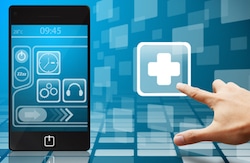The Disruption of Healthcare Has Already Begun
 The first of a two-part guest article contributed by Pediatric Rheumatologist and healthcare thought leader Paul Rosen, MD, a regular contributor to our blog. Dr. Rosen identifies some of the key drivers in healthcare transformation, which might be seen as a field of landmines or opportunities.
The first of a two-part guest article contributed by Pediatric Rheumatologist and healthcare thought leader Paul Rosen, MD, a regular contributor to our blog. Dr. Rosen identifies some of the key drivers in healthcare transformation, which might be seen as a field of landmines or opportunities.
I was planning to write a piece on the future of medicine. However, the future of medicine has already arrived.
The disruption of a system plagued by high cost, waste of resources, medical errors, and system-centered care, is currently being transformed. Over $2 billion in capital is entering the health care space each quarter to support the effort.
Health care start-ups are emerging at a record pace. The technology revolution is breaking down the traditional silos between health and wellness. The Internet of things and consumer interest in the measured-self is blurring the lines between sports performance, gaming, wellness and medicine.
Here are some of the key drivers of this transformation:
Big data: Just as the accumulation of large datasets enabled disruption of other industries, the rush for building large data sets is happening in health care. One example is the Harris Center for Precision Wellness at Mt. Sinai Medical Center in New York. The Center uses large genomic data sets and combines them with large clinical data sets to predict models of disease for large populations of patients. The Center utilizes data scientists to build models for preventative medicine and personalized health.
Transparency: Consumers have an increasingly voracious appetite for high value, differentiated data that will inform their health care decisions. Propublica is publishing data on surgical complications based on individual surgeons for some procedures.
The Leapfrog Group has been publishing patient safety information and rating hospital safety over 15 years. Health systems are recognizing that consumers demand this data. University of Utah Health System, Cleveland Clinic, UPMC, and North Shore-LIJ Health System are a few of the health systems who have started to post their physician satisfaction scores, as rated by patients, on their websites
Convenience using mHealth: Traditional face-to-face visits are starting to be supplanted by companies that can provide care for patients via a mobile device. In exchange for paying a small, out-of-pocket fee, patients can avoid missing work, paying a co-pay, traveling to a doctor’s office and waiting in a waiting room. These start-ups are focusing on both primary care and specialty care and are delivering health care in a convenient, cost effective model that consumers value.
HealthTap has a network of virtual doctors who see patients by smartphone or Apple Watch. If you have a rash and your local dermatologist does not have an opening in the office for a month, just take a photo and upload it to FirstDerm. For women’s health issues, reach out to Maven Health. Their tag line captures the value they deliver to their customers: “you have ten places to be and a waiting room isn’t one of them.”
CONTINUED: Watch for part two of this article titled: Healthcare Disruptions: For Better or Worse?
Paul Rosen, MD








